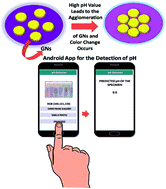Gold nanostructures for the sensing of pH using a smartphone†
Abstract
Recently, metal nanostructures have been found to be capable of recognizing small changes in their surrounding environment, which can be utilized as significant sensing tools. In this study, we demonstrated colorimetric sensing of pH by gold nanostructures (GNs) using a simple smartphone. An indigenously developed Android app based on the CIELab 1931 analysis, which could run in a smartphone, was used for the precise determination of the pH value of liquid media. The pH value of an unknown solution obtained from the developed Android app was also compared with that obtained from the conventional ratiometric technique and a commercial pH meter. In another endeavor, it was found that the synthesized GNs demonstrated a high energy transfer efficiency from a donor (namely, the rhodamine 6G, (Rh 6G)) dye. This property of the GNs can be utilized further in the future for studying different bimolecular activities within the human body. It was found that the photoluminescence (PL) of Rh 6G was quenched when it was kept in the vicinity of the synthesized GNs, which was explained in terms of the Förster energy transfer mechanism. Thus, the present study will open up a plethora of opportunities for researchers to employ the nanostructures of gold and other metals in developing low-cost and Internet of Things (IoT)-based sensing devices using only a smart phone.



 Please wait while we load your content...
Please wait while we load your content...